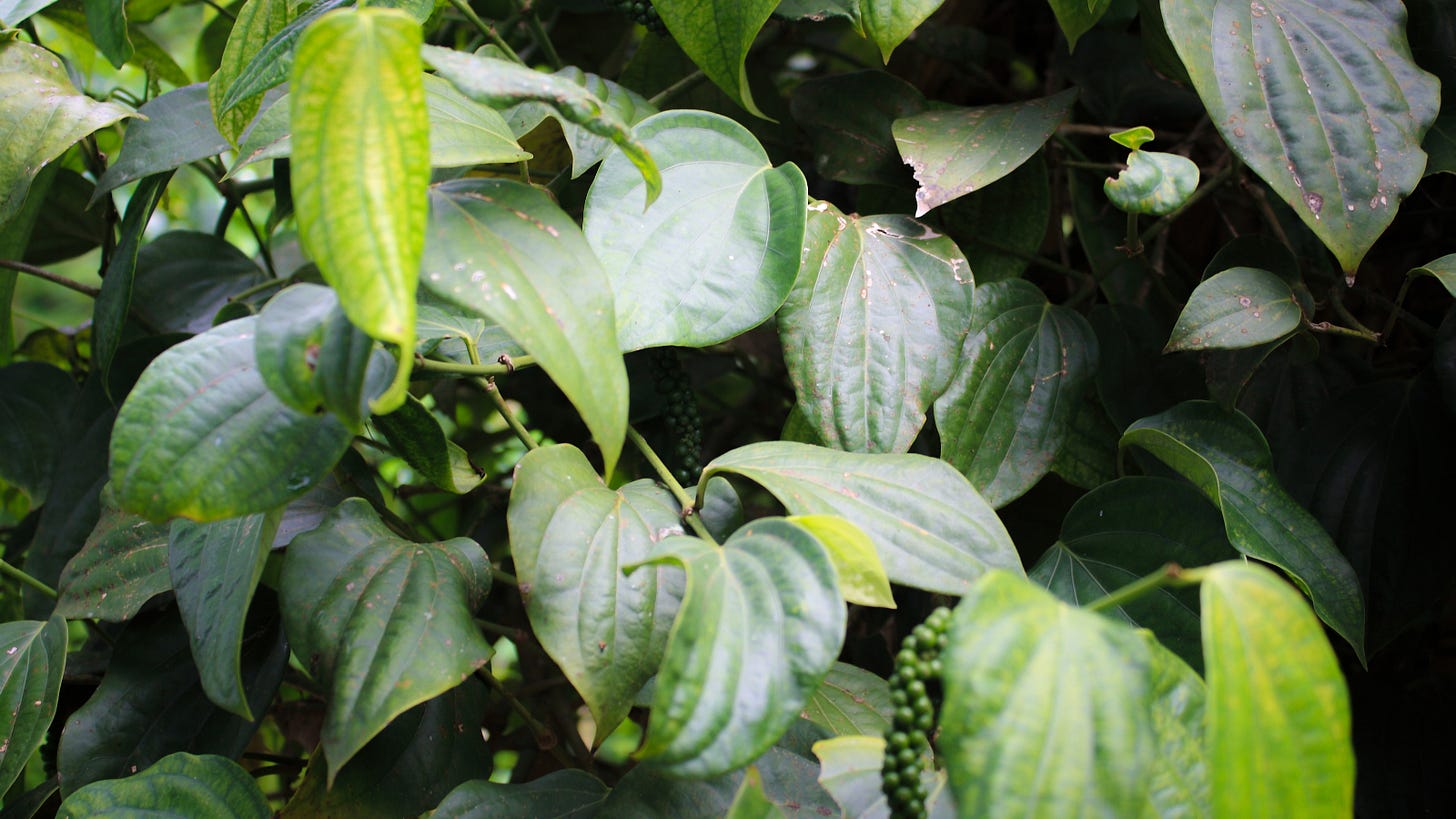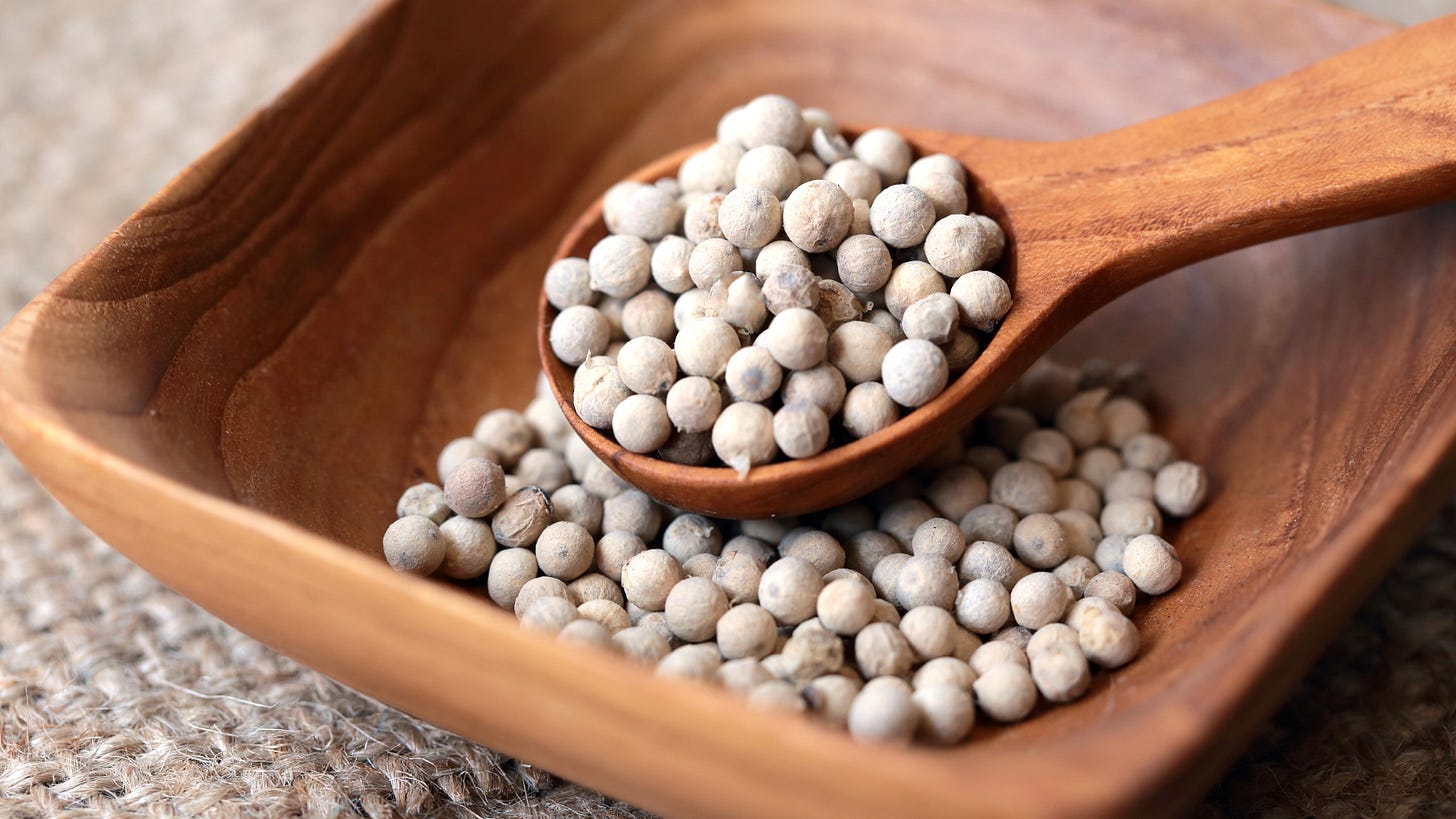Black pepper: It hurts so good!
What gives black pepper its heat? How did this jungle vine become a part of the human diet? I explore the history and chemistry of the peppercorn and how it interacts with pain receptors.
This unassuming spice graces dining tables in homes and restaurants worldwide. Now accessible to all, it was once only available to the wealthiest families. Today, we dust the tiny specks of its ground fruit onto our meats and vegetables as a part of the pre-meal ritual. It adds a bit of heat, that extra kick to our food that takes a meal from simply tasty to delightful.
Origins of the peppercorn plant
The black pepper plant (scientific name: Piper nigrum in the Piperaceae family) is a perennial woody vine that originated in the tropical forests of Kerala in southern India, though today it is cultivated in regions spanning from India to Asia. If you’re a fan of the Polynesian root drink known as kava (scientific name: Piper methysticum) and have noted the peppery undertones of that beverage, you shouldn’t be surprised to learn that kava is a close relative to black pepper and is found in the same genus.
Black Pepper: How it’s made
To turn this tropical forest plant into a delicious spice, some initial processing is required. The familiar black peppercorn we use in many dishes is the dried fruit of the pepper plant. To create black pepper, the small drupes are harvested while still green and unripe.
In case you're wondering, a drupe is a botanical term used to describe a type of fleshy fruit with a thin skin and a central stone containing a seed. Other well-known drupe fruits include plums, cherries, and olives.

There are a couple of ways to dry the fruit:
Blanch them in boiling water before laying them out to sun dry; or
Hand-pick apart the fruits and leave them to sun dry naturally.
The drying process can take up to a week, during which time the fruit is fermented by the natural microbes found on its skin and, as a result, turn black and with the outer layer wrinkling. This is where black pepper gets its name—from the dark color of the dried fruit.
What about white pepper?
Did you know that white pepper comes from the same plant as black pepper? The difference lies in the processing of the fruit. White peppercorns are made by selecting fully ripe or nearly ripe drupes instead of the green unripe fruit used for black pepper. The ripe drupes are boiled in water until the fruit's flesh and skin soften and can then be easily rubbed off to reveal the white seeds. These seeds are then dried in the sun, like the process for black pepper.
It's fascinating to learn how a simple change in processing can result in such a different flavor and appearance! While black pepper has a sharp and pungent taste, white pepper has a milder and slightly earthy flavor.
What about red peppercorn?
Red peppercorns come from a different family than black or white pepper—the Anacardiaceae family, which includes mangoes, cashews, and poison ivy. This means that people with allergies to tree nuts or poison ivy may be able to safely consume black or white pepper but should avoid red peppercorns.
Medicinal history
Black pepper has a rich history as a highly valued medicine in Traditional Chinese and Ayurvedic practices. It was used to treat various ailments, and black pepper essential oils are still used in pain management. Its trade dates back at least 4,000 years, and it was even used by Egyptians in mummification practices. Peppercorns became a major spice of trade in the Roman Empire, with references to its steep cost appearing in texts written by Pliny the Elder in the 1st Century AD. As black peppercorn spread across Europe, it quickly took its place as a cure-all for various diseases, ranging from constipation to toothache. Its value was so great that it was even used as a form of money.
How it works
Black pepper's signature spiciness comes from piperine, a molecule found in the peppercorn. Plants produce molecules like piperine to defend against insects, microbes, and herbivores.
Piperine activates pain-sensing nerve cells in your mouth called nociceptors, creating the intense sensation you feel. Black peppercorns also contain a mix of volatile compounds named terpenes that give it a complex flavor with notes of pine, mint, and citrus. The plant produces these terpenes for their insect-repellent and antimicrobial properties. In comparison to white pepper, black pepper has a more complex taste due to the presence of these terpenes in its black fermented skin.
From a pharmacological standpoint, piperine is a fascinating molecule. Studies have shown that it can change the way our bodies metabolize, or process, specific drugs. For example, piperine can enhance the bioavailability—or the proportion of the drug taken that enters circulation in the body—of certain drugs, including some antibiotics and pain medications, by a range of up to 30-200%. Read my earlier post on turmeric to learn more about its importance in getting the most significant benefit from that spice.
What about stability?
The chemicals responsible for peppercorn's flavor and pharmacological activity are easily lost when exposed to air and light. This is why pre-ground pepper lacks the complex flavors of freshly ground pepper.
To experience the difference for yourself, try comparing the flavor of pre-ground pepper to freshly ground black peppercorns on a neutral food base, such as white rice or a starchy potato. You'll likely notice a significant difference in flavor and aroma.
Takeaway lesson: To get the most out of your peppercorn, it's best to buy them whole and freshly grind them just before use. This will ensure you get the full range of flavors and medicinal benefits this ancient spice offers.
Want to learn more about black pepper? Check out this episode on the Foodie Pharmacology podcast.
Yours in health, Dr. Quave
Nature’s Pharmacy is written by Cassandra L. Quave, Ph.D.—a disabled writer, speaker, podcast host, professor, wife, mother, explorer, and ethnobotanist. Dr. Quave is Associate Professor of Dermatology and Human Health at Emory University School of Medicine. She has written about her work as a scientist in The Plant Hunter: A Scientist’s Quest for Nature’s Next Medicines (Viking/Penguin 2021). During the day, she teaches college courses and leads a large group of talented research scientists studying medicinal plants in the search for new life-saving drugs from nature. In her spare time she hosts the Foodie Pharmacology podcast and writes this newsletter. Her main goal is to share the incredible science behind the medicines found in nature. This newsletter is only possible through the generous support of fellow Nature’s Pharmacy community members. To support this effort and join the community, subscribe below.











Thanks for the pepper lesson – I had no idea that black and white pepper came from the same plant!
Thanks, Cassie. Very nice account! Dan